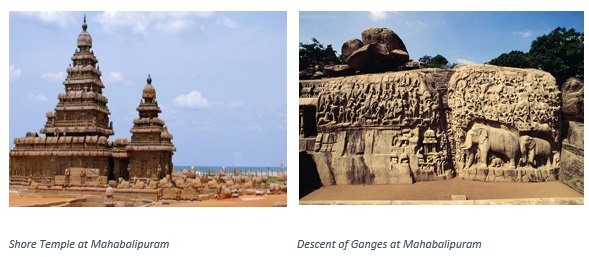Tamil Nadu has more than 30,000 temples and about 2000 of them are in the Cauvery Delta. Immense prosperity and an enlightened monarchy paved the way for an advanced sculpture, arts, and music heavily intertwined with a spiritual quest in this fertile land. The Pandyas, the Cholas, the Pallavas, the Vijayanagara kings, and the Marathas were great temple builders. Unfortunately, our Delhi-centric history books have reduced their contribution to Indian culture and heritage to a few footnotes. This was a whirlwind tour of the wonderful land.
DAY 1 – Kancheepuram
After landing in Chennai, Kancheepuram was the first destination. There are 108 temples in Kanchipuram and for a busy traveller, it is impossible to cover them all in a day. There is a Vishnu Kanchi and Shiva Kanchi. The Varadaraja Koil at Vishnu Kanchi is the most important temple. The pilgrims make a point to touch the famous lizards on the roof after seeing the main deity. The Kailasnath temple, dedicated to Lord Shiva, is an extraordinary work of sculpture made of sandstone. It is not a very busy temple. The priest will make one enter and exit through small holes in the wall to end the cycle of births and deaths. Only if it was so easy! The Ekambareshwar temple has a ‘Bhoolingam,’ which is the lingam dedicated to the Earth element. Undoubtedly, the most important temple is the Kamakshi Amman temple. Words cannot capture the experience of the morning rituals at this glorious temple. The Kanchi Mutt is a must visit in Kanchi. The great Adi Shankara established it and holds a prominent place in Hindu traditions. The ‘Samadhi’ of the liberated sage Chandrasekhara Saraswati is here.
Most temples in Tamil Nadu close from 12 noon to 4 pm. It is best for a pilgrim to travel during the afternoon hours. The Kanchi Mutt is open from morning to night; and one might use the afternoon hours in Kanchipuram to shop for its famous and exquisitely beautiful sarees.
DAY 2 – Tiruchirapally
The road from Kanchi to Tiruchirappalli (Trichy) is a beautiful four hours by road. Srirangam is an extremely important Vishnu temple for the Vaishnavites. It comes before entering the main city of Trichy, hence very convenient for a first stop when travelling from Kanchi. The temple is a huge place spread over 156 acres with seven layers of enclosing walls- almost a small town inside. A person can study the temple architecture for weeks together. The sculpture is fascinating and so is the main deity.
Jambukeshwar temple is a Shiva temple close to this place, and it is important for the Shaivites. It houses the Shiva lingam in the form of ‘Jala Lingam’- a lingam representing the water element. The lingam takes the form of the five primary elements in South India. Earth, fire, water, air, and space are represented at Kancheepuram, Tiruvannamalai, Trichy, Srikalahasti, and Chidambaram respectively.
The final visit in Trichy was Samayapuram Mariamman Temple, a form of goddess Durga or Aadi Shakthi. The main idol, made of sand and clay, have no abhishekams conducted to it, but instead to the small stone statue in front. People believe that the Goddess has enormous healing powers. The devotees buy small metallic replicas of body parts which need healing and deposit them in the donation box, as a ritual. The replicas, sold outside, are not expensive to buy. Samayapuram is the second most wealthy temple in Tamil Nadu after Palani, and the crowds in the night left us no doubt of that.
DAY 3 – Tanjore
We proceeded to Tanjore, 50 kilometres from Trichy. On the way, a necessary visit is the Grand Anicut or the Kallanai dam built on the river Cauvery. It is a stone dam constructed 2000 years ago by a Chola King called Karikalan. It is the oldest stone dam in the country still in use and the second oldest in the world. The British engineers re-modelled the dam much later; and the dam is a remarkable sight. Our present democracy and engineers could take lessons from an enlightened monarchy and the quality of engineering in the past.
The most important temple in Tanjore and in the Cauvery delta would be the Brihadishvara Temple, or the Big Temple dedicated primarily to Lord Shiva. It is an overwhelming temple, and as one enters the temple premises, most first-timers take out a gasp of amazement and wonder. The architecture, the inscriptions, the mural paintings on the ceilings can engage an interested person for weeks or even months together. In the fewest words, the temple is an experience. The 1000th anniversary was celebrated with gusto recently in 2010. Raja Raja Chola built this grand structure, which also was a place to run the kingdom. Imagine that, running the state from temple premises with Dharma and the gods watching your actions! It is now a World Heritage Site as declared by UNESCO. Some of the most popular monuments in India and abroad pale into insignificance when compared to the Big Temple of Thanjavur or Tanjore.
There are other places to visit in Tanjore, but lack of time narrowed our visits to two others. The Saraswati Mahal Library located in the premises of Thanjavur Palace is a necessary visit. It is one of the oldest libraries in Asia and has on display a rare collection of Palm leaf manuscripts and papers written in Tamil, Telugu, Marathi, Hindi, and other Indian languages. The collection comprises over 49,000 volumes, though only a tiny fraction of these are on display. The bulk of this collection is in Sanskrit. It was the singular vision of the great Maratha king called Serfoji or Serobji, which gave the library its form and shape. There is a fantastic short audio-visual programme played in the auditorium at regular intervals on the history of Thanjavur; and is necessary to see it to understand the historical richness of this place. This library can be followed by a visit to the museum in the same premises with its collection of sculptures, brass pieces, and paintings. There is a shop in the premises too for all the shopping needs related to Thanjavur. The famous Tanjore paintings made of gold are wonderful; and undoubtedly expensive. We appreciated them from a distance- the purchasing postponed for a later day with fuller wallets!
Thiruvaiyaru is about 10 kilometres from this place and for the musically inclined, it is a place where Saint Thyagaraj lived and later attained Samadhi. We visited his house and the hallowed place of his Samadhi on the banks of River Cauvery. The journey across the water bodies and the lush greenery makes one realize the tremendous prosperity suffusing this area. It is no wonder that the Cauvery is a cradle of so much of arts, literature, and music.
We proceeded to Kumbakonam, and on the way, visited the Swamimalai temple, a very ancient temple dedicated to Lord Murugan or Subramayeshwar, son of Lord Shiva. It is believed to be in existence from the Sangam period of 2nd century BC but later modified by the Chola kings. It is one of the six places where the Lord is supposed to have lived; and not surprisingly holds immense importance to his devotees. After Palani, this is an important temple for Lord Murugan, a place where the Lord as per legend, taught the ‘Pranava Mantra’ to Lord Brahma.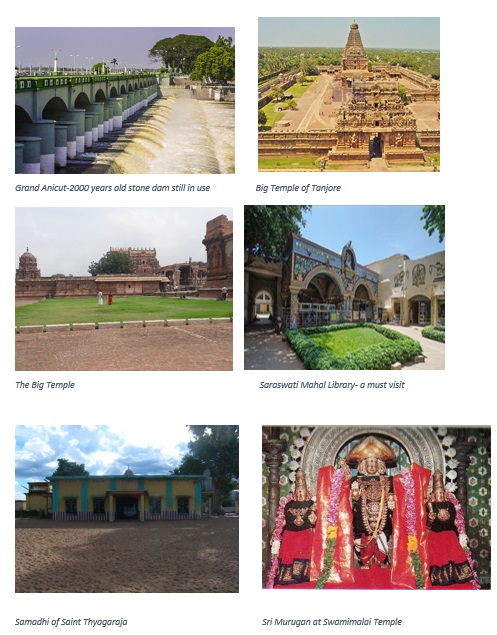
DAY 4 – Kumbakonam
It is difficult not to fall in love with Kumbakonam, where the ancient and the modern mix most naturally. It is the holiest-of-holy places with nearly 80 temples in the town itself; all ancient and significant. It can be also set as a base for the visit to the Navagraha temples, the ancient temples dedicated to the nine planets. The Navagraha temple tour itself would take 2-3 days and Kumbakonam at the very minimum would take 2 days to cover. One day at Kumbakonam boils down to a few temples, not necessarily the most important, but on the choice of the pilgrim. Kumbakonam temples mainly belong to the architecture of the first Chola phase built between 850 CE and 985 CE.
The Adi Kumbeswarar temple is a Shiva temple- a huge architectural masterpiece. The main idol unusually bends to one side a little; and its brittle nature disallows daily bathing. Do not miss to appreciate the extraordinary stone carvings in the temple, especially the chains hanging from the ceiling, carved from stone and not metal. This temple also houses Goddess Mangalambigai and Juhareswar; the latter believed to get rid of fevers.
The Sarangapani temple is the third most important temple for Vaishnavites after Tirupati and Srirangam; and it is the largest temple of Kumbakonam. As the legend goes, Goddess Mahalaxmi married Lord Vishnu’s form as Sarangapani (the one who holds the Sarangam, Vishnu’s bow) here. The idol of the temple is in a half lying, and half raised posture. The Lord as Sudarshana in the Chakrapani temple has his third eye open; and holds the Chakra and other weapons in his eight arms.
The other two temples we could visit by afternoon when the temples close were the Nageswarar temple (where three days in a year the sun rays directly fall on the lingam), and the Ramaswamy temple. The latter is a legacy of one of Nayak kings of Thanjavur of the 16th-17th centuries, who were great patrons of arts. The Ramaswamy temple is famous for its Tanjore paintings and vegetable dye paintings depicting the Ramayana. The coronation scene depicted in stone in the main sanctum, is very unusual. I had seen something like this for the first time, and it left me quite touched. We could squeeze to visit one Navagraha temple dedicated to the Sun, the head of all planets. It is an ancient temple and is about 15 kilometres from Kumbakonam. This temple is unique in that all the other planets also have their own shrines; and that too without their weapons in a benevolent mood!
No visit to Kumbakonam can be complete without visiting the holiest Mahamaham tank and sprinkling oneself with the waters if one does not have time to bathe. In the evening, we had time to visit just one temple, the amazing Airavateswar temple. The sculptural beauty of this place is beyond any description and one can spend hours at this not so busy place. At least it was not when we visited. In Kumbakonam, for fans like myself, is the house of Srinivasa Ramanujan. Sastra University maintains it and is on the street opposite the Sarangapani temple. The brass vessels make for some fine shopping to those who have the time and inclination. The gods in heaven make the ‘degree’ coffee of Kumbakonam and one should not fail to have it as much as one’s stomach allows.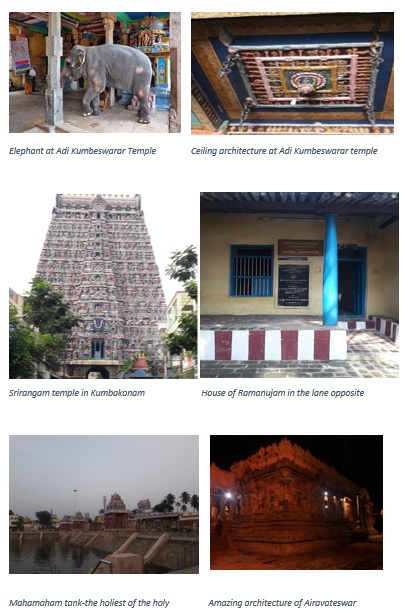
DAY 5 – Pondicherry via Chidambaram
The final lap of the journey was to Pondicherry. We had time for only two important temples on the way, giving Mayiladuthurai a sad miss for another day. The first was the Vaitheeswaran Koil, the Navagraha temple dedicated to Mars. It is a very ancient temple belonging to 7th century CE. Vaitheeswaran is a form of Lord Shiva as the great healer. The legend is that Shiva took this form to heal 4448 ailments. The Pallavas originally built it with later modifications by the Cholas, Nayaks, and the Maratha kings. It is also a place where ‘Nadi Jyothiskam’ practitioners are popular, specialising in predictions made in palm leaf manuscripts by the saints of yore. This is for the astrologically inclined, but this practice has no connection with the traditions of the temple itself.
Chidambaram was the next place. Lord Shiva as the famous Nataraja is the main deity in ‘The Temple’ of Chidambaram. The highest level of art, sculpture, science, symbolism, and spirituality combine at an extraordinary level to leave one gasping at our amazing past. The temple has references from the 5th century in the Tamil literature and is arguably the most famous temple in the Cauvery delta. Some may give the preference to the Big Temple at Tanjore. A silver Nataraja, the Lord as the cosmic dancer, is the principal icon of this temple. Chola kings rebuilt the Chidambaram temple with stone and gold in the 10th century. Shiva lingam is symbolised in the subtlest element-space- at this temple. The dance of numbers related to the material and spiritual is evident in the architecture and sculpture- a supreme mysticism called ‘Chidambaram Rahasyam.’
The curtains whisked in the space just to the right of the main icon, after the rituals, ‘reveals’ the final secret. One ‘sees’ an empty space – God perhaps as the formless in a supreme Advaitic statement. The form of Nataraja itself has left people in raptures across time and place, the famous in contemporary times being Fritzof Capra, the author of ‘The Tao of Physics.’ In this book he draws amazing parallels between Eastern mysticism and modern physics. His words on the Nataraja form captures the quintessence of the cosmic dance of creation and destruction; and his quotes find a place in the plaque under the Nataraja idol presented by the Indian government to CERN at Geneva. The text of the plaque goes like this:
Ananda K. Coomaraswamy, seeing beyond the unsurpassed rhythm, beauty, power, and grace of the Nataraja, once wrote of it “It is the clearest image of the activity of God which any art or religion can boast of.”
More recently, Fritjof Capra explained that “Modern physics has shown that the rhythm of creation and destruction is not only manifest in the turn of the seasons and in the birth and death of all living creatures, but is also the very essence of inorganic matter,” and that “For the modern physicists, then, Shiva’s dance is the dance of subatomic matter.”
It is indeed as Capra concluded: “Hundreds of years ago, Indian artists created visual images of dancing Shivas in a beautiful series of bronzes. In our time, physicists have used the most advanced technology to portray the patterns of the cosmic dance. The metaphor of the cosmic dance thus unifies ancient mythology, religious art and modern physics.”
We reached Pondicherry by evening. If one is travelling by road, one needs to register the vehicle with the transport authority before moving around in the Union Territory.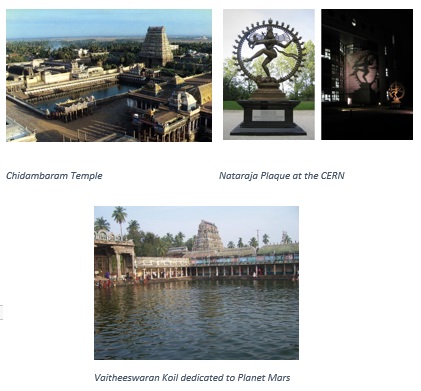
DAY 6 – Pondicherry
Pondicherry is a place where anyone with a heart will fall in love with. The great walks on the beach road where vehicles are not allowed in the morning and evening, the 24 hour cafe on the beach road serving great coffee and other delicacies, the parallel neat streets set in a rectangular grid, the Ashram which houses the samadhi of the great modern saint Sri Aurobindo, the Vinayaka temple of exquisite beauty dedicated to Lord Ganesha, the shopping on the busy Grand Bazaar on the Jawaharlal Nehru street, the fantastic restaurants dotting the city, the extreme friendliness of people make a stay in Pondicherry a memorable event. The innumerable beaches, especially the Paradise beach, would make one desire for many repeats. It is a quaint town where the modern and the ancient mix with a distinct French flavour. The Chief Minister can be seen walking in the mornings with just a couple of security guards around him! That was indeed the most shocking sight one can hope to have in India!
Pondicherry has a hoary history. It was also called Vedapuri in ancient times and derived its name from the Vedapureswar temple where the teachers and students of the Vedas lived. The place from mid-16th century frequently changed hands between the French and the British colonizers. It was finally ‘gifted’ to the French by the British in the late 1850s. The French-Anglican wars on Indian soil were fought with the help of Indian soldiers on both sides! An assertive Indian is no wonder disliked by everyone.
A must visit place in Pondicherry is Auroville, an experimental township where people from various countries and races live in harmony. This was conceived by and founded in 1968 by Mirra Alfassa (known as “the Mother”, a spiritual partner of Sri Aurobindo) and designed by architect Roger Anger. The statement from the Mother says: Auroville wants to be a universal town where men and women of all countries are able to live in peace and progressive harmony, above all creeds, all politics, and all nationalities. The purpose of Auroville is to realize human unity.
The Matrimandir, a golden metallic sphere in the center of town, is literally the centre of attraction. It is a meditation place of exquisite beauty, but one needs passes 24-48 hours earlier to enter the Mandir. Hence, a visit inside the place needs advanced planning.
Sri Aurobindo, a great spiritual giant, was also a revolutionary hounded by the British to finally find sanctuary in this French colony. He was a great nationalist and his ideas, if followed, could have given India independence a few decades earlier. Sadly, the Congress neglected him, and the post-Independent Indian historians seriously ignored him.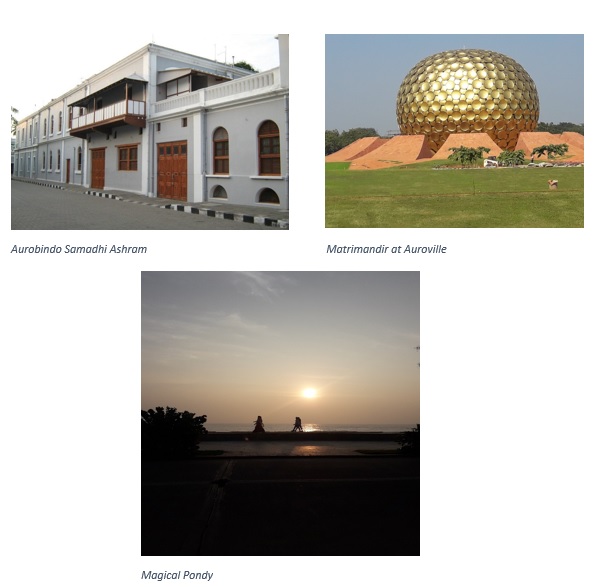
DAY 7 – Chennai via Mahabalipuram
The final stop was Mahabalipuram (or Mamallapuram in olden times). The Pallavas ruled from the 3rd to the 9th centuries of the Common Era, and their golden period was between 650 CE to 750 CE. They were great patron of arts, sculpture, temples, and music. Their capital was Kanchipuram and Mahabalipuram was an important port town. The group of monuments at Mahabalipuram is a collection of 7th and 8th century religious monuments and a UNESCO World Heritage site. The site has 40 ancient rock-cut monuments which are architectural masterpieces and includes the largest open-air rock reliefs in the world- the Descent of the Ganges, or Arjuna’s Penance. This became a model for South Indian temple architectural forms and even in the Far East places like Cambodia and Java.
Mahabalipuram has a great beach too, and a person can spend one or two full days at this lovely place which is about 60 kilometres from Chennai. A train to catch in the evening did not allow us much time at this beautiful place. Promising to return one day, we hesitatingly made our way back to Chennai.
We had a couple of spare hours in Chennai. We spent them in the newest and the fastest growing state of the country-a shopping mall!
Tamil Nadu, especially the Cauvery Delta, holds something fascinating for everybody. A Dvaitist, an Advaitist, a foreigner, a non-Hindu, or an atheist too – any traveller interested in arts, history, culture, or spirituality- would journey through this incredible land with awe and wonder.
Featured Image: esamskriti


